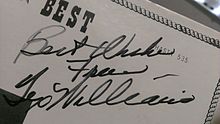
Calligraphy is a visual art related to writing. It is the design and execution of lettering with a pen, ink brush, or other writing instrument. Contemporary calligraphic practice can be defined as "the art of giving form to signs in an expressive, harmonious, and skillful manner".

Penmanship is the technique of writing with the hand using a writing instrument. Today, this is most commonly done with a pen, or pencil, but throughout history has included many different implements. The various generic and formal historical styles of writing are called "hands" while an individual's style of penmanship is referred to as "handwriting".

The Palmer Method of penmanship instruction was developed and promoted by Austin Palmer in the late 19th and early 20th centuries. It was intended to simplify the earlier "Spencerian method", which had been the main handwriting learning method since the 1840s. The Palmer Method soon became the most popular handwriting system in the United States.

Cursive is any style of penmanship in which characters are written joined in a flowing manner, generally for the purpose of making writing faster, in contrast to block letters. It varies in functionality and modern-day usage across languages and regions; being used both publicly in artistic and formal documents as well as in private communication. Formal cursive is generally joined, but casual cursive is a combination of joins and pen lifts. The writing style can be further divided as "looped", "italic", or "connected".
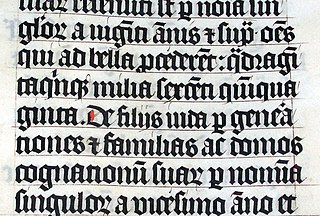
Blackletter, also known as Gothic script, Gothic minuscule or Gothic type, was a script used throughout Western Europe from approximately 1150 until the 17th century. It continued to be commonly used for Danish, Norwegian, and Swedish until the 1870s, Finnish until the turn of the 20th century, Latvian until the 1930s, and for the German language until the 1940s, when Hitler officially discontinued it in 1941. Fraktur is a notable script of this type, and sometimes the entire group of blackletter faces is referred to as Fraktur. Blackletter is sometimes referred to as Old English, but it is not to be confused with the Old English language, which predates blackletter by many centuries and was written in the insular script or in Futhorc. Along with Italic type and Roman type, blackletter served as one of the major typefaces in the history of Western typography.
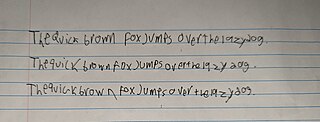
Dysgraphia is a neurological disorder and learning disability that concerns impairments in written expression, which affects the ability to write, primarily handwriting, but also coherence. It is a specific learning disability (SLD) as well as a transcription disability, meaning that it is a writing disorder associated with impaired handwriting, orthographic coding and finger sequencing. It often overlaps with other learning disabilities and neurodevelopmental disorders such as speech impairment, attention deficit hyperactivity disorder (ADHD) or developmental coordination disorder (DCD).

Italic script, also known as chancery cursive and Italic hand, is a semi-cursive, slightly sloped style of handwriting and calligraphy that was developed during the Renaissance in Italy. It is one of the most popular styles used in contemporary Western calligraphy.

The Rotunda is a specific medieval blackletter script. It originates in Carolingian minuscule. Sometimes, it is not considered a blackletter script, but a script on its own. It was used mainly in southern Europe.
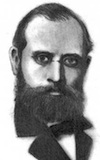
Charles Paxton Zaner was an American calligrapher, pen artist, and teacher of penmanship.

Secretary hand or script is a style of European handwriting developed in the early sixteenth century that remained common in the sixteenth and seventeenth centuries for writing English, German, Welsh and Gaelic.
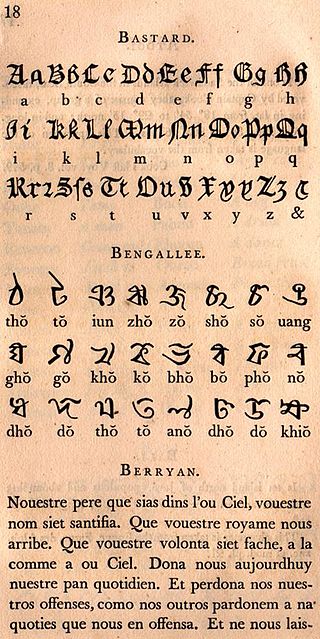
Bastarda or bastard was a blackletter script used in France, the Burgundian Netherlands and Germany during the 14th and 15th centuries. The Burgundian variant of script can be seen as the court script of the Dukes of Burgundy. The particularly English forms of the script are sometimes distinguished as Bastarda Anglicana or Anglicana.

Spencerian script is a script style based on Copperplate script that was used in the United States from approximately 1850 to 1925, and was considered the American de facto standard writing style for business correspondence prior to the widespread adoption of the typewriter. Spencerian script, an American form of cursive handwriting, was also widely integrated into the school system as an instructional method until the "simpler" Palmer Method replaced it. President James A. Garfield called the Spencerian script, "the pride of our country and the model of our schools."

The term "chancery hand" can refer to either of two distinct styles of historical handwriting.
Handwriting movement analysis is the study and analysis of the movements involved in handwriting and drawing. It forms an important part of graphonomics, which became established after the "International Workshop on Handwriting Movement Analysis" in 1982 in Nijmegen, The Netherlands. It would become the first of a continuing series of International Graphonomics Conferences. The first graphonomics milestone was Thomassen, Keuss, Van Galen, Grootveld (1983).
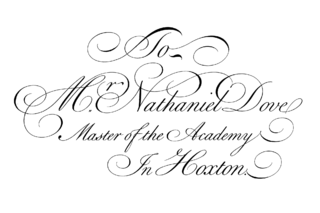
A copperplate script is a style of calligraphic writing most commonly associated with English Roundhand. Although often used as an umbrella term for various forms of pointed pen calligraphy, Copperplate most accurately refers to script styles represented in copybooks created using the intaglio printmaking method.

Court hand was a style of handwriting used in medieval English law courts, and later by professionals such as lawyers and clerks. "It is noticeably upright and packed together with exaggeratedly long ascenders and descenders, the latter often and the former occasionally brought round in sweeping crescent shaped curves".
A book hand was any of several stylized handwriting scripts used during ancient and medieval times. It was intended for legibility and often used in transcribing official documents.

Ronde is a kind of script in which the heavy strokes are nearly upright, giving the characters when taken together a round look. It appeared in France at the end of the 16th century, growing out from a late local variant of Gothic cursive influenced by North Italian Renaissance types in Rotunda, a bookish round Gothic style, as well as Civilité, also a late French variant of Gothic cursive. It was popularized by writing masters such as Louis Barbedor in the 17th century.

A teaching script is a sample script that serves as a visual orientation for learning to write by hand. In the sense of a guideline or a prototype, it supports the demanding process of developing handwriting skills and abilities in a visual and illustrative way.

The Zaner-Bloser is a teaching script for handwriting based on Latin script as well as a system of penmanship instruction, which originated around 1904 at the Zanerian College of Penmanship in Columbus, Ohio. Charles P. Zaner (1864–1918) and Elmer W. Bloser (1865–1929), originally a Spencerian Method instructor, developed their teaching script with the aim of allowing learners an easier transition from print writing to cursive. The Zaner-Bloser Method first teaches block letters and then cursive in order to enable written expression as quickly as possible and thus develop the ability to write. Material relating to the method of instruction practiced by Zaner and Bloser is still being published by the Zaner-Bloser Company, a subsidiary of Highlights for Children.






